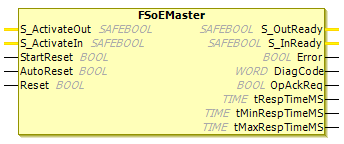FSoEMaster
Tip
The version of the function block as described here corresponds to the latest version of the function block in Version list of function blocks.
Using the function block instance (driver instance)
In the application the FSoEMaster function block is used to
Change the default values
Acknowledge errors manually
Diagnose the connection to a safety device
To do this, the corresponding instance of the FSoEMaster function block must be made visible in a program by means of VAR_EXTERNAL <device name>: FSoEMaster.
Function block: FSoEMaster

Name | Data Type | Initial Value | Description, parameter values |
|---|---|---|---|
|
|
| Input for controlling the outputs
|
|
|
| Input for controlling the inputs
|
|
|
| FSoE name of the <auto-acknowledge startup error> input for automatic acknowledgment of errors at startup. See Input for automatic acknowledgement of startup errors The Input for automatic acknowledgement of startup errors safety note must be observed. |
|
|
| FSoE name of the <auto-acknowledge interruption> input for the automatic acknowledgment after interruptions. See Input for automatic acknowledgement after interruption The Input for automatic acknowledgement after interruption safety note must be observed. |
|
|
| FSoE name of the <Acknowledgment edge> for manual acknowledgment. See Input for acknowledgement edge (manual acknowledgement) The Input to the acknowledgement edge (manual acknowledgement) notes must be observed. |
Name | Data Type | Initial Value | Description, parameter values |
|---|---|---|---|
|
|
| Indicates that the output data is valid and sent to the safety device.
Note: The output changes to |
|
|
| Indicates whether the input variables contain valid process data from the device (instead of substitute values)
|
|
|
| Error display |
|
|
| |
|
|
| FSoE name of the <Acknowledgment request> output for requesting a manual acknowledgment. See Output for acknowledgement request The Output for acknowledgement request must be observed. |
|
|
| Current cycle time of the data exchange (see below: Time measurement) |
|
|
| Minimum value of the cycle time of the data exchange (see below: Time measurement) |
|
|
| Maximum value of the cycle time of the data exchange (see below: Time measurement) |
Time measurement
The FSoEMaster function block provides three outputs for the monitoring of the telegram processing time. The outputs are used for diagnosing the FSoE communication.
The expired time of the IEC timer is taken as the measured cycle time of a telegram (Master->Safety Device->Master). In order not to falsify the measurements, only valid responses are considered. The time is measured between two telegrams received by the safety device. This means at least one bit in the complete telegram shows a change.
The function block supplies both the current (tRespTimeMS), the minimum (tMinRespTimeMS) and the maximum (tMaxRespTimeMS) cycle time of a telegram.